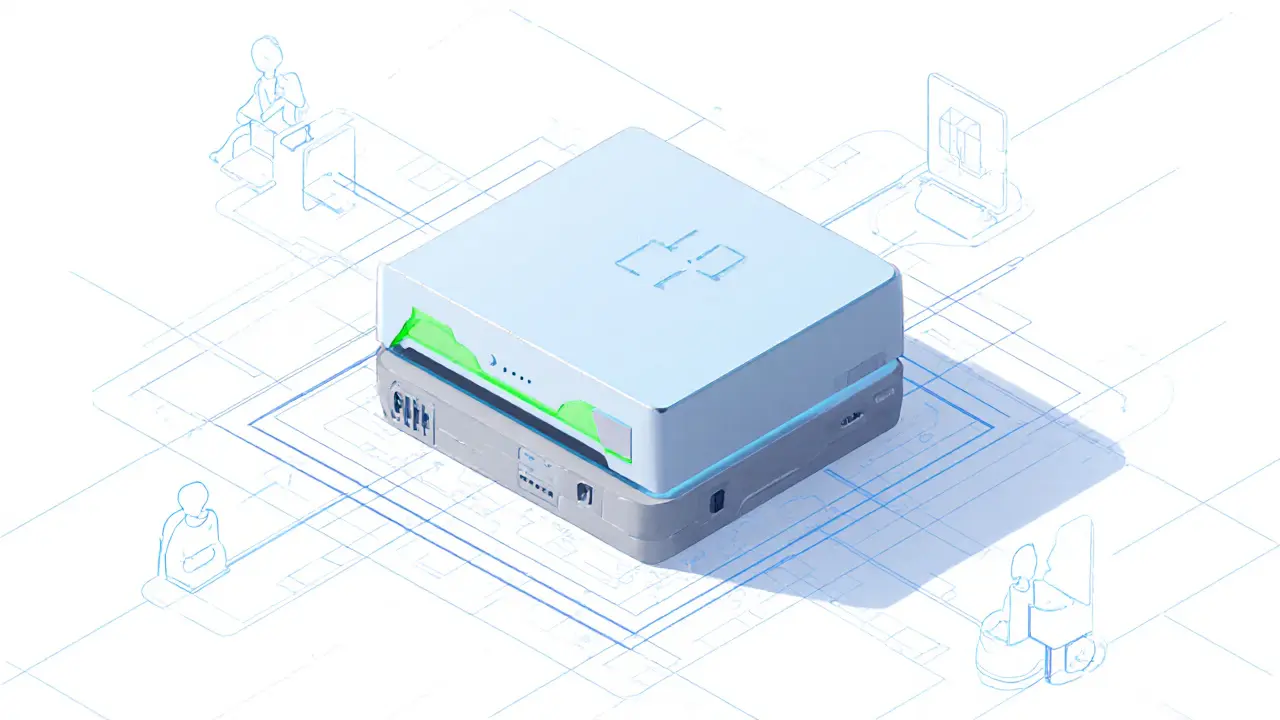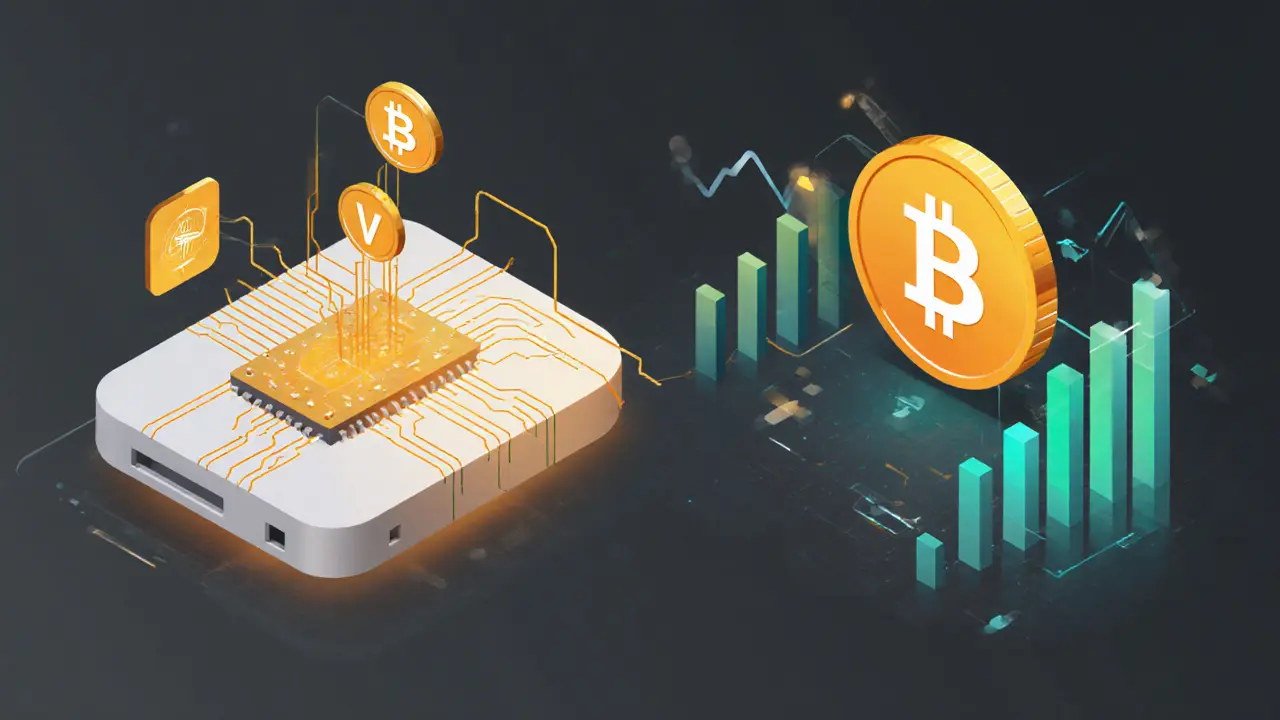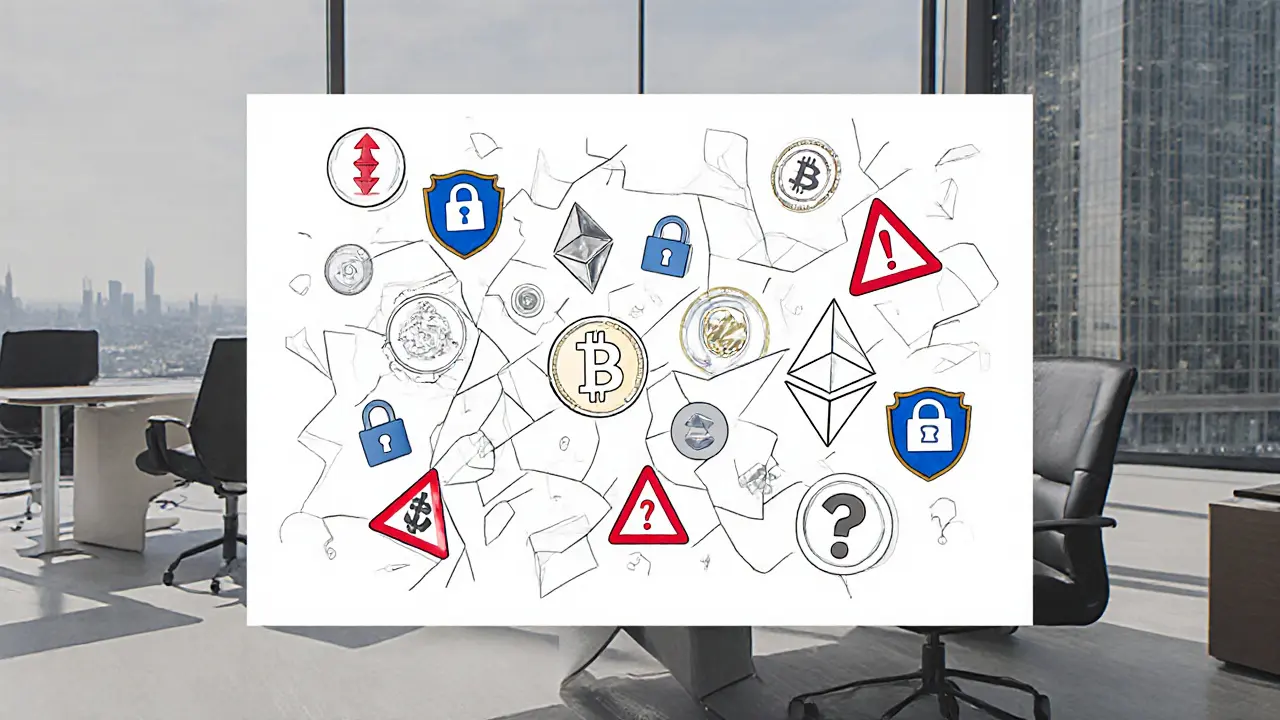Key Challenges Facing DePIN Networks and How to Overcome Them

DePIN Challenge Assessment Tool
This tool helps assess the key challenges facing DePIN networks and suggests practical mitigation strategies based on your inputs.
Identified Challenges & Solutions
When you hear Decentralized Physical Infrastructure Networks (DePIN) described as a blockchain‑powered way to run real‑world hardware like sensors, routers, or storage devices without a central owner, the idea sounds revolutionary. Yet, anyone trying to build or join a DePIN quickly runs into a laundry list of roadblocks. This article breaks down the most common pain points, shows why they matter, and offers practical ways to keep the network moving forward.
Quick Takeaways
- Bootstrapping requires both providers and users to reach a critical mass - a classic chicken‑and‑egg problem.
- Token volatility can scare away investors and make services unaffordable.
- Coordinating physical hardware through smart contracts adds technical complexity.
- Scalability is limited by blockchain latency and the weakest‑link hardware.
- Regulatory gray zones, quality‑control gaps, and security risks all slow adoption.
1. Network Effect and Bootstrapping
DePINs need a two‑sided market. Network effect the phenomenon where a service becomes more valuable as more participants join drives growth, but it only kicks in after enough providers and users are on board. Physical Resource Networks (PRNs) - think community‑owned Wi‑Fi hotspots or edge‑computing nodes - suffer especially because coverage must be geographically dense. Without sufficient nodes, users see nothing useful; without users, providers earn nothing.
Bootstrapping tactics include early incentive pools, strategic partnerships with local businesses, and focused geographic pilots that demonstrate tangible value before expanding.
2. Token Economics and Incentive Alignment
The token economy a set of rules that dictate how digital tokens are minted, distributed, and used for rewards is the financial backbone of DePINs. Designing it well is tough:
- Rewards must be high enough to cover hardware costs and maintenance.
- Token price swings can turn a lucrative venture into a loss‑making one overnight.
- Long‑term sustainability often relies on token inflation, which can dilute value.
Solutions involve using stablecoins for payments, tiered reward structures that taper off as the network matures, and transparent treasury dashboards that let participants audit inflows and outflows.
3. Technical Coordination and Smart‑Contract Complexity
Running real hardware through a blockchain means smart contracts self‑executing code that enforces agreements without intermediaries must understand usage patterns, verify performance, and trigger payments. That adds layers of engineering:
- Off‑chain data feeds (oracles) are needed to report real‑world metrics.
- Version upgrades of hardware must be synchronized across thousands of independent owners.
- Dispute resolution mechanisms often rely on reputation scores rather than legal contracts.
Hybrid architectures that keep heavy‑weight coordination off‑chain while using the chain for settlement strike a good balance.
4. Scalability and Performance Limits
Blockchain latency (often seconds to minutes) conflicts with real‑time services like video streaming or low‑latency computing. When a node requests bandwidth, waiting for a transaction confirmation can break the user experience.
Layer‑2 solutions, sidechains, or even permissioned roll‑ups can shave milliseconds off confirmation times, but they also introduce new trust assumptions. Network designers must match the performance tier of the blockchain to the service class they intend to offer.
5. Regulatory and Compliance Uncertainty
Traditional infrastructure is tightly regulated - think telecom licenses, energy grid standards, or building codes. DePIN projects operate across borders and often lack clear guidance from regulators.
Key compliance hurdles include:
- Data‑privacy rules (GDPR, CCPA) when sensors collect personal information.
- Telecommunications statutes that dictate spectrum usage.
- Financial regulations governing token sales and rewards.
Early legal counsel, jurisdiction‑by‑jurisdiction roadmaps, and self‑certification frameworks help reduce friction.

6. Quality Assurance and Service‑Level Guarantees
Without a central operator, service level agreements formal contracts that define performance metrics and penalties are replaced by algorithmic reputation scores and escrowed payments.
Implementing continuous monitoring (e.g., ping tests for network latency, storage read/write benchmarks) and publicly posting results builds trust. Community‑run arbitration panels can mediate disputes when metrics fall short.
7. Capital Investment and Risk Distribution
Purchasing routers, solar panels, or edge servers demands upfront capital. In a DePIN, that cost sits on individual participants rather than a single corporate balance sheet.
Risk‑sharing mechanisms - such as pooled insurance funds, shared depreciation schedules, and co‑ownership models - distribute the financial blow of hardware failure or market downturns.
8. Interoperability and Standards
With many independent DePIN projects, standards drift quickly. Imagine two community Wi‑Fi networks using different authentication protocols; users would need separate apps for each.
Open‑source reference stacks, cross‑project working groups, and alignment with existing IoT standards (like Matter or LoRaWAN) promote interoperability and lower the entry barrier for new participants.
9. Security and Trust Challenges
Beyond blockchain hacks, physical nodes face theft, tampering, and ransomware. A compromised router could become a launchpad for DDoS attacks against the whole network.
Best practices include tamper‑evident enclosures, hardware‑root‑of‑trust modules, and regular firmware signing checks. Reputation layers should penalize nodes that exhibit anomalous behavior.
10. Energy Consumption and Environmental Impact
Running a blockchain consensus algorithm alongside power‑hungry hardware can raise carbon footprints. Some DePINs mitigate this by:
- Choosing low‑energy consensus mechanisms (e.g., proof‑of‑stake).
- Powering nodes with renewable sources like solar or wind.
- Implementing dynamic load‑balancing to shut down idle hardware.
Transparent reporting of energy metrics attracts environmentally conscious users and can satisfy emerging regulations.
11. Emerging Solutions and Mitigations
Even with these hurdles, the ecosystem is evolving. Hybrid models blend decentralized ownership with centralized oversight for critical functions like compliance checks. Decentralized autonomous organizations (DAOs) are experimenting with treasury‑managed upgrades, while AI‑driven monitoring tools automate performance verification.
Successful DePINs tend to focus on a narrow vertical first - such as community broadband in a city block - prove economic viability, then replicate the model elsewhere.
Frequently Asked Questions
Why do DePINs struggle with network effects?
Because they need both providers of physical hardware and users who consume the service. Without one side, the other sees no value, creating a chicken‑and‑egg loop that is hard to break without upfront incentives.
Can stablecoins solve token‑volatility issues?
Stablecoins can peg rewards to a fiat value, shielding participants from wild price swings. However, they introduce counterparty risk and regulatory scrutiny, so projects often combine both native tokens for governance and stablecoins for payments.
What technical stack enables real‑time payments in DePIN?
Layer‑2 roll‑ups or sidechains that settle micro‑transactions off‑chain and batch‑commit to the main chain provide the needed speed. Projects like Optimism or zkSync are popular choices.
How do DePIN projects handle regulatory compliance across borders?
They map each jurisdiction’s requirements, implement modular compliance modules (e.g., KYC, data‑localization), and often limit certain services to regions where rules are clear. Legal counsel and a compliance DAO are common safeguards.
What role does interoperability play for DePIN growth?
Interoperability lets users switch between networks without reinstalling apps or buying new hardware, expanding the addressable market. Shared standards also lower development costs for new entrants.


Latoya Jackman
August 12, 2025 AT 15:00The overview nicely categorizes the challenges, and the suggested mitigations seem well‑aligned with industry best practices.
karsten wall
August 19, 2025 AT 13:40From a systems‑theoretic perspective, the interplay between token economics and physical node provisioning engenders a classic case of coupled equilibria. The article correctly flags the chicken‑and‑egg dilemma, yet it could further explore multi‑criteria optimisation frameworks that balance capital efficiency with service availability. Moreover, incorporating decentralized identifier (DID) standards can streamline onboarding while preserving privacy. On the scalability front, roll‑up architectures such as zk‑Rollups offer promising latency reductions, but they introduce trust assumptions that merit explicit discussion. In practice, a hybrid on‑chain/off‑chain coordination layer, perhaps orchestrated via libp2p, mitigates bottlenecks without sacrificing auditability. Finally, regulators increasingly treat DePINs under the umbrella of critical infrastructure, so a compliance‑by‑design approach is advisable.
Keith Cotterill
August 26, 2025 AT 12:20One must, of course, appreciate the lofty ambition, however, the micro‑economics of tokenised incentives can, at times, become an existential quagmire; the volatility factor alone can erode any marginal return, rendering the whole enterprise, arguably, a speculative mirage... Moreover, the insistence on exclusively blockchain‑native governance may, paradoxically, stifle the very decentralisation it purports to champion!
C Brown
September 2, 2025 AT 11:00Oh great, another "revolutionary" network that will solve all our problems-right after the sun stops rising. It's like watching a bad sequel where the plot never catches up.
Darrin Budzak
September 9, 2025 AT 09:40I like how the piece walks through each pain point without glossing over the hard truths. The suggested pooled‑insurance model for hardware risk is a solid idea. It reminds us that community‑driven projects still need safety nets. Hopefully more builders will adopt these pragmatic solutions.
Megan King
September 16, 2025 AT 08:20Super helpful breakdown! The part about using stablecoins for payments really hits the nail on the head. Also, love the tip on hybrid architectures – keeps things slick. Keep the tips comin, this is gold.
Rachel Kasdin
September 23, 2025 AT 07:00Yo, DePINs need some serious US‑first policy backing if they want to thrive.
Nilesh Parghi
September 30, 2025 AT 05:40Contemplating the essence of decentralized infrastructure leads one to question the very nature of ownership. If nodes are scattered, does sovereignty become a collective rather than an individual attribute? The article hints at this, yet a deeper philosophical lens could illuminate the social contract implied by DePINs. In any case, the balance between trustless protocols and human governance remains delicate.
Raphael Tomasetti
October 7, 2025 AT 04:20Interoperability is the linchpin for scaling DePIN ecosystems; adopt open standards now.
Jenny Simpson
October 14, 2025 AT 03:00While everyone’s busy championing decentralisation, they ignore the fact that too much freedom can spawn chaos. The article’s optimism feels misplaced when real‑world constraints are ignored. Perhaps a more sober assessment is warranted.
Lisa Strauss
October 21, 2025 AT 01:40Great job highlighting the key hurdles! I'm optimistic that with community support we can overcome these obstacles. Let’s keep sharing practical solutions and learning from each other.
Eugene Myazin
October 28, 2025 AT 00:20Loving the practical tone of this piece. The mix of technical and regulatory advice feels spot‑on for new builders. Keep the insights coming!
Noel Lees
November 3, 2025 AT 23:00Totally agree with the need for hybrid architectures – they provide the best of both worlds. Also, the emphasis on energy‑efficient consensus mechanisms is crucial for sustainability. 😊
Adeoye Emmanuel
November 10, 2025 AT 21:40Delving into the philosophical underpinnings of DePINs, one encounters a profound dialectic between autonomy and interdependence. The article rightly notes that token economics aim to align incentives, yet it stops short of interrogating the moral implications of monetizing essential services. When we embed financial instruments into the fabric of physical infrastructure, we risk commodifying access to basic utilities, thereby reshaping societal norms about entitlement. Moreover, the reliance on blockchain consensus mechanisms introduces a paradox: the pursuit of trustlessness may inadvertently erode communal trust if participants perceive the system as opaque or overly complex. The proposed solution of employing low‑energy proof‑of‑stake protocols mitigates environmental concerns, but it also concentrates staking power, potentially reproducing centralized hierarchies. To truly democratize infrastructure, governance frameworks must incorporate liquid democracy or quadratic voting to distribute decision‑making authority more equitably. Additionally, the integration of oracles for off‑chain data raises questions about data provenance and the susceptibility to manipulation, which could undermine the very reputation systems the article praises. A robust approach would entail multi‑source verification and cryptographic proof of data integrity. In the realm of regulatory compliance, a modular compliance stack that can be activated per jurisdiction offers flexibility, yet it also imposes a compliance burden that may deter grassroots participation. Therefore, a balance must be struck between legal adherence and accessibility. Finally, the emphasis on interoperability cannot be overstated; aligning DePIN protocols with established IoT standards like Matter ensures that devices can seamlessly transition between networks, fostering a vibrant ecosystem. In sum, while the article provides a solid technical foundation, a deeper exploration of ethical, governance, and systemic implications is essential for the sustainable evolution of decentralized physical infrastructure networks.